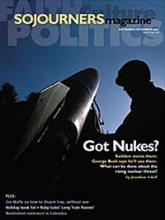Saddam Hussein with nuclear weapons would be a real threat. But even without Iraq as a member, the growing nuclear family-with the United States firmly at the helm-already provides a clear and present danger as politicians argue for the use of these previously "unthinkable" weapons. The Bush administration has a stated policy of "pre-emptive strikes" to counter other countries' nuclear programs, and the government's latest Nuclear Posture Review lays out plans for building new nuclear weapons and for a widening array of possible targets.
So nukes are back in the news, in some ways more frightening than ever. But, as author Jonathan Schell writes in this issue, nuclear weapons and the threat they pose never really went away, just out of public consciousness. Meanwhile, yesterday's weapons became the seeds of today's nuclear dilemma.
But history also holds stories of hope, from the test ban campaign of the early 1960s to the large-scale disarmament movement of the 1980s. And the churches have played a key role in these movements against nuclear insanity.
History has shown that prayer, organizing, and actions of conscience can educate the public and influence the governments of the world. The tools of hope and strategic nonviolence can unleash an unexpected power-a power that stands up even to nuclear weapons. -The Editors
Read the Full Article
